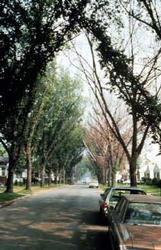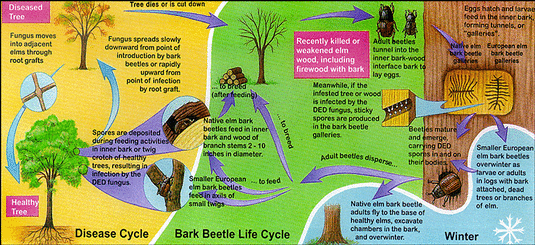Dutch Elm Disease (DED)
"At one time, the American elm was considered to be an ideal street tree because it was graceful, long-lived, fast growing, and tolerant of compacted soils and air pollution. Then Dutch elm disease (DED) was introduced and began devastating the elm population...The challenge before us is to reduce the loss of remaining elms and to choose suitable replacement trees for the ones we cannot save". -Linda Haugen,USDA Forest Service Plant Pathologist - St. Paul, Minnesota.
First discovered in the United States in 1930, Dutch Elm Disease is a devastating killer of elm trees. Few varieties of elm are not susceptible to the disease, which rapidly spreads once the tree has become infected. Currently, DED has destroyed more than fifty percent of all elm trees within the Northern half of North America. Minot is no exception when it comes to the number of trees lost to the disease. Several hundred elm trees have been lost in Minot alone, since the disease was first found in Mandan, North Dakota in 1969. Only the extreme northwestern section of the state has not felt the effects of DED. Luckily, the numbers of diseased trees have declined since it first emerged 50 years ago, from over 100 cases to only 20 in 2005. Unfortunately, there is no know cure for the disease. Although preventative measures exist, most are extremely expensive and not economically possible. Therefore, the best treatment for an infected tree is to simply remove it. Dutch Elm Disease is the result of bark beetles or root grafts that bring a fungus, known as Ceratocystis ulmi, into the tree's xylem. From the xylem (the main water and mineral conducting tissue), the fungus spreads rapidly, triggering the tree's self-survival mode. The disease will generally begin in the crown of the tree, followed by a downward progression through the larger branches of the tree. Over time, the tree will form "gums" within its tissue, ultimately causing the tree to wilt and die.
However, it is important to note that the beetle itself is not the threat to the tree. It is the fungus that is responsible for the death of the elm tree, not the otherwise harmless, native borers. Unfortunately, the beetle is a perfect host for the spores associated with the DED fungus. These spores then attach themselves to the beetle's body to gain entry into the tree. The elm bark beetle then bores into the bark of a given tree, and tunnels along the bark-wood interface. As the beetle feeds, it scores (tears) the wood. This feeding is most typical in the bark of small to medium-sized branches (those 2-4 inches in diameter). If the beetle is carrying the spores of the DED fungus, a DED infection will most likely follow. This process is responsible for many of the elm trees within North Dakota becoming infected with DED. Adjacent trees are then vulnerable to infection via root grafts.
Some of the most telling signs that a tree has DED is wilting, curling, and/or yellowing of leaves on the upper portion of one or more branches. A progressive dying of leaves and branches then follows, ultimately, killing the entire tree. A brown discoloration of the wood may also be noticed, along with streaking visible in the wood of small branches, twigs, or even the trunk. These symptoms can occur rapidly, and trees will often die within only a few months of initial infection. However, it is important to be aware that both the symptoms and progression of DED can differ greatly depending on the tree or method by which it becomes infected. For example, a tree that has been infected with DED by means of root grafting may be slower to show symptoms, accompanied by leaf flagging on suckers and lower branches. However, some trees thought to have contracted DED (by evidence of wilting and yellowing leaves) have in fact only been harmed by squirrel injuries, elm scale, or storm damage. Therefore, it is important that proper testing be done to identify DED before making a final determination concerning your tree's health.
While DED is not curable, it can be prevented and controlled to a certain degree. One way to help prevent DED from spreading is to maintain your elm and keep it healthy. This includes removing dead, weak or dying elm wood. Also, remove any woodpiles from your property containing elm logs. This eliminates potential breeding sites for the elm bark beetles, who like to colonize in such wood. Another method to prevent the spread of DED to elm in your area is by means of chemical sprays or injections. However, these treatments may produce a considerable amount of wounding, loss of leaves, and can be very costly (since the treatment will need to be repeated). Unfortunately, removing the tree completely is the only sure way to stop the spread of DED.

